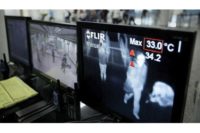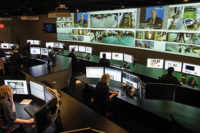
|
| Photo Courtesy of FLIR |
This fall, for the first time ever, Ebola turned up in the United States, raising concerns about how infectious diseases can spread via air travel, and discussion about how airports can help in the efforts of to curtail a potential pandemic. “Airports can help prevent the spread of infectious diseases in a number of ways. Thermal imaging cameras can be used to determine whether a passenger has a high temperature, for example, while behavior monitoring can be used to identify passengers that look ill,” shared John Nemerofsky, CEO, Xentry Systems Integration, Columbus, Ohio.
Thermal imaging cameras and sensors that can detect body heat such as produced by fevers are now common in all airport environments for surveillance purposes. These security tools offer an array of data and information to enhance situational awareness, and some U.S. airports are currently using thermal cameras along their perimeters to detect the presence of humans and other objects.
One off-the-record source stated these types of cameras are “not designed to read a person’s specific body temperature.” But does that mean they could not be used to help halt the potential spread of infectious diseases such as SARS, Avian Flu and Ebola?
“These cameras are particularly useful for detection in limited visibility situations,” said Safety and Security Executive Donald R. Zoufal, SDI, Chicago. “However, the infrared thermal cameras that can be used for monitoring human temperature are actually a special subset of thermal cameras. These cameras are finely calibrated to discern slight differences in temperature.” He added, “While they employ the same principles of using infrared technology to identify the presence of changes in temperature of objects in a field of view, they differ in their level of sensitivity from the thermal cameras used for health screening.”
FLIR Systems makes thermal imaging cameras and sensors, developing and manufacturing products that enable anyone to literally “see the heat,” according to the company. FLIR’s thermal cameras generate real-time video data that allows both thermal imaging and accurate temperature measurement.
“Thermal imaging technology can serve as an effective tool for measuring variances in body temperature in a non-invasive manner, which could certainly be helpful as a first line of defense in the screening process of passengers,” said FLIR CEO Andrew Teich. “Compared to spot thermometers which require single-point, one-to-one measurement, our thermal cameras are ideal tools for mass screenings to continue the flow of traffic in high-volume areas without alarming the passengers.”
Products such as FLIR’s A320 and T-series handheld thermal devices are in used in various airports throughout the Middle East and Asia to screen individuals for elevated body temperatures. The company began selling its aforementioned handheld thermal devices during the first SARS outbreak, 10 years ago. Later, according to Teich, they were used during the H1N1 Bird-Flu outbreaks.
Infrared thermal image camera technology is not limited to hand-held devices. Independent scientific testing of some of the infrared thermal image camera technology seems to suggest it can be effective in identifying persons with elevated body temperature, Zoufal shared. Compared with a hand-held, individual scanner it has the advantage of operating at a considerable distance and processing larger numbers of individuals, Zoufal added.
“While it is slightly less accurate than the hand-held scanners and is subject to greater environmental influences, it seems to be recognized as a reliable technology,” stated Zoufal. “I think this technology can identify febrile persons in a crowd of people; the bigger and more difficult question to answer is what to do with that information once it is gained. What protocol is the information supporting? What do you do when a person is identified?” And will it play a larger role in the future of pandemic control, in transportation hubs such as U.S. airports.
“Use of camera technology with regard to this type of screening will likely expand, as it has expanded in other areas,” said Zoufal. “Other countries have been using thermal camera screenings with various degrees of success. It has been used in response to threats from SARS, influenza, and dengue fever, by different countries with different perceptions of success.” Among (but not limited to) those countries, are Canada, Australia, Singapore, and Hong Kong. In the latter two countries it “is currently being utilized in conjunction with Ebola screening in Kenya and South Africa (among other places),” added Zoufal.
Of course, the threat of Ebola spreading across the United States is slim, but as the global travel industry continues to grow, and increasingly more often world travelers sit side-by-side in airplanes, the threat of infectious diseases most certainly will rise. It is important to remember that while security tools may help identify potential risk, there isn’t a one-stop camera that can reveal Ebola or SARS.
“While our products can be used as screening mechanisms for the detection of elevated body temperature, they are not stand-alone tools,” reminded Teich. “Additional screening is required once a person’s elevated body temperature is flagged. We do feel, however, that this technology is one of the most efficient and least invasive means of first-line screening in high-traffic areas, such as airports and other major points of entry.”
For now, there are five designated airports with advanced screening procedures, such as passenger temperature readings, in place to screen arrivals from Ebola-affected countries at Kennedy International in New York, Newark Liberty International, Washington Dulles International, O’Hare International in Chicago and Hartsfield-Jackson International in Atlanta. If the need arises, the security industry is prepared to assist the government.
“Because of an airport’s evolving risk profile, it is important that such facilities leverage technologies that can easily integrate with other systems to deliver a high level of situational awareness that will help combat security threats,” added Nemerofsky. “ Being able to connect alarms from IP cameras with access control parameters helps streamline standard operating procedures and allows security personnel to be more effective.”








